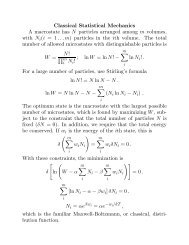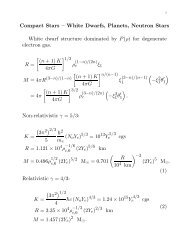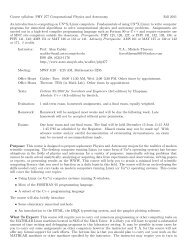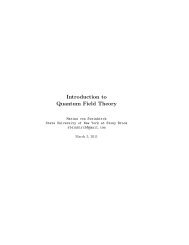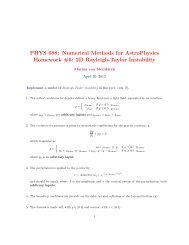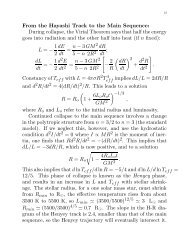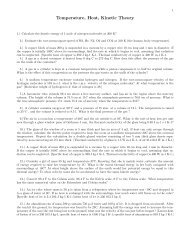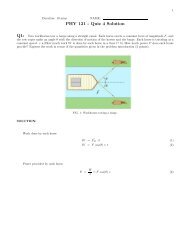Problem Set 2
Problem Set 2
Problem Set 2
You also want an ePaper? Increase the reach of your titles
YUMPU automatically turns print PDFs into web optimized ePapers that Google loves.
Physics 523 - Homework #2Due – April 4, 2006Question 1Consider a collection massless (i.e., trace particles) but luminous particles inside a uniformdensity dark halo. Suppose that the particles have an isothermal distribution function,f(E) =ρ 1(2πσ 2 ) 3/2 e−E/σ2 =ρ 1(2πσ 2 ) 3/2 e −1/2v2 −φσ 2 ,where E = total energy per unit mass, φ = gravitational potential energy per unit mass, v =velocity, and σ = the one dimensional velocity dispersion.a) Show that the density distribution is ρ = ρ 1 e −φ/σ2 .b) Use φ = − ∫ r0Force • dr to derive the potential and hence show that ρ(r) is gaussian. Theeasiest way of doing this is to express the gravitational Force in the above integral in terms ofρ(r) and r.Question 2(a) Using the ρ(r) derived in the Question 1, show that the projected density distribution,Σ(x), is also gaussian. The relationship between ρ(r) and Σ(x) can be expressed as,(see attached handout).∫ ∞rΣ(x) = 2x (r 2 − x 2 ρ(r)dr) 1/2(b) Define the core radius in the same way as for a self-gravitating isothermal, i.e,Σ(r c )Σ(0) = 1 2 .Then derive the central mass density ρ 0 as a function of r c and σ.(c) Compare the result in (1b) with the central mass density, ρ 0K , derived in class, i.e, theKing Model,ρ 0K =9σ24πGrc2 ,(See discussion of core parameters in the Elliptical Galaxies and Bulges lectures.) If you assumedthat the dark matter halo had the same r c and σ as the test particles, the King Model would give
– 2 –you this central density for the halo.What is the ratio,ρ 0ρ 0Kof the true central density to the value you would get from the King Model.Question 3Consider again a galaxy with an isothermal velocity distribution,f(E) =ρ 0(2πσ 2 ) 3/2 eE/σ2 =ρ 0φ−1/2v2(2πσ 2 e σ) 3/2 2 ,where ρ 0 is the central density and the other symbols are the same as in Question 1. Derive,(a) the mean velocity v, and(b) the mean square of one component of velocity, say v 2 x.



